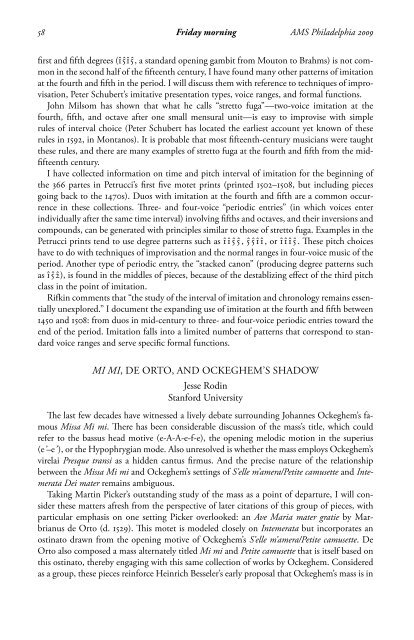AMS Philadelphia 2009 Abstracts - American Musicological Society
AMS Philadelphia 2009 Abstracts - American Musicological Society
AMS Philadelphia 2009 Abstracts - American Musicological Society
You also want an ePaper? Increase the reach of your titles
YUMPU automatically turns print PDFs into web optimized ePapers that Google loves.
58 Friday morning <strong>AMS</strong> <strong>Philadelphia</strong> <strong>2009</strong><br />
first and fifth degrees (1̂ 5̂ 1̂ 5̂ , a standard opening gambit from Mouton to Brahms) is not common<br />
in the second half of the fifteenth century, I have found many other patterns of imitation<br />
at the fourth and fifth in the period. I will discuss them with reference to techniques of improvisation,<br />
Peter Schubert’s imitative presentation types, voice ranges, and formal functions.<br />
John Milsom has shown that what he calls “stretto fuga”—two-voice imitation at the<br />
fourth, fifth, and octave after one small mensural unit—is easy to improvise with simple<br />
rules of interval choice (Peter Schubert has located the earliest account yet known of these<br />
rules in 1592, in Montanos). It is probable that most fifteenth-century musicians were taught<br />
these rules, and there are many examples of stretto fuga at the fourth and fifth from the midfifteenth<br />
century.<br />
I have collected information on time and pitch interval of imitation for the beginning of<br />
the 366 partes in Petrucci’s first five motet prints (printed 1502–1508, but including pieces<br />
going back to the 1470s). Duos with imitation at the fourth and fifth are a common occurrence<br />
in these collections. Three- and four-voice “periodic entries” (in which voices enter<br />
individually after the same time interval) involving fifths and octaves, and their inversions and<br />
compounds, can be generated with principles similar to those of stretto fuga. Examples in the<br />
Petrucci prints tend to use degree patterns such as 1̂ 1̂ 5̂ 5̂ , 5̂ 5̂ 1̂ 1̂ , or 1̂ 1̂ 1̂ 5̂ . These pitch choices<br />
have to do with techniques of improvisation and the normal ranges in four-voice music of the<br />
period. Another type of periodic entry, the “stacked canon” (producing degree patterns such<br />
as 1̂ 5̂ 2̂ ), is found in the middles of pieces, because of the destablizing effect of the third pitch<br />
class in the point of imitation.<br />
Rifkin comments that “the study of the interval of imitation and chronology remains essentially<br />
unexplored.” I document the expanding use of imitation at the fourth and fifth between<br />
1450 and 1508: from duos in mid-century to three- and four-voice periodic entries toward the<br />
end of the period. Imitation falls into a limited number of patterns that correspond to standard<br />
voice ranges and serve specific formal functions.<br />
Mi Mi, DE ORTO, AND OCKEGHEM’S SHADOW<br />
Jesse Rodin<br />
Stanford University<br />
The last few decades have witnessed a lively debate surrounding Johannes Ockeghem’s famous<br />
Missa Mi mi. There has been considerable discussion of the mass’s title, which could<br />
refer to the bassus head motive (e-A-A-e-f-e), the opening melodic motion in the superius<br />
(e’–e’ ), or the Hypophrygian mode. Also unresolved is whether the mass employs Ockeghem’s<br />
virelai Presque transi as a hidden cantus firmus. And the precise nature of the relationship<br />
between the Missa Mi mi and Ockeghem’s settings of S’elle m’amera/Petite camusette and intemerata<br />
dei mater remains ambiguous.<br />
Taking Martin Picker’s outstanding study of the mass as a point of departure, I will consider<br />
these matters afresh from the perspective of later citations of this group of pieces, with<br />
particular emphasis on one setting Picker overlooked: an Ave Maria mater gratie by Marbrianus<br />
de Orto (d. 1529). This motet is modeled closely on intemerata but incorporates an<br />
ostinato drawn from the opening motive of Ockeghem’s S’elle m’amera/Petite camusette. De<br />
Orto also composed a mass alternately titled Mi mi and Petite camusette that is itself based on<br />
this ostinato, thereby engaging with this same collection of works by Ockeghem. Considered<br />
as a group, these pieces reinforce Heinrich Besseler’s early proposal that Ockeghem’s mass is in










